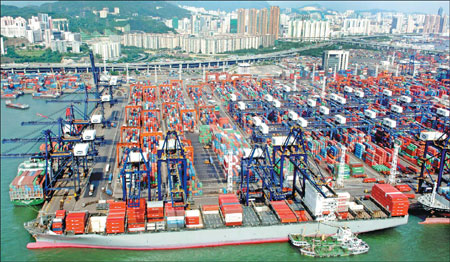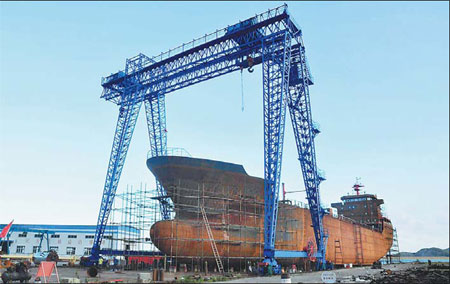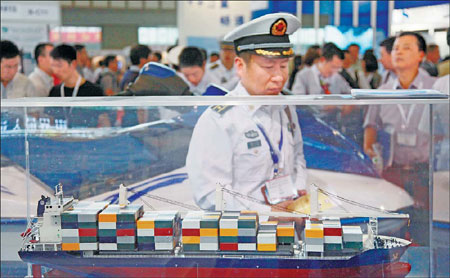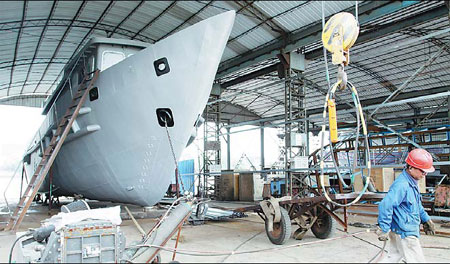Shipping industry finds itself adrift
Updated: 2013-05-24 09:10
By Alfred Romann for China Daily (China Daily)
|
|||||||||||
|
Despite the decline of the shipping industry, the Kwai Tsing container terminals in Hong Kong remain among the busiest in the world. Er QiZheng / China Daily |
|
Beilun Yisida Shipyard in Ningbo city, Zhejiang province, is struggling to survive amid a global decline in the shipping industry. Hu Xuejun / for China Daily |
Challenging times likely to remain until at least next year
After buoyant times, the shipping industry is experiencing that sinking feeling, with all hope of a bottoming out and rebirth having been smothered.
Shipowners and those who charter vessels were optimistic during the first two months of this year, but during the past couple of months the paucity of orders for new vessels has all but dashed hopes. Times are likely to remain challenging until at least next year.
"The shipping industry is at historically low levels, and it can't get much lower. If you are looking to buy ships, you couldn't find a better time. The only issue is that you would have to sustain this market for a few years before you started to make a lot of money," says Ravindranath Raghunath, head of chartering at the Noble Group. "Since 1997, the market has not been any lower than it is today."
China's largest shipping company, China COSCO Holdings, reported large losses for 2012, adding to significant losses in 2011. The Danish giant AP Moller-Maersk A/S has warned that global overcapacity is a threat to the industry. Dry bulk shipping rates in 2012 were a fraction of the 2010 highs and have yet to recover. All of this has put the industry in a funk.
Between 2003 and 2008 the mood was exuberant. They were boom years and the industry dreamed of almost perpetual expansion. Powered by economic growth in China and its seemingly inexhaustible demand for raw materials, the shipping industry reached record highs in 2008. Demand for space in container, bulk and tanker ships far outstripped supply, so owners could easily set almost whatever price they chose to hire out ships, while shipping companies could virtually set their own fees.
Massive profits pushed companies to order ships in record numbers, but those orders marked the beginning of the end of the good times. The addition of hundreds of ships to the global fleet vastly increased the supply of cargo capacity.
By itself, that increase would have imposed significant downward pressure on prices, but the industry was also hit by the global financial crisis. Economies in North America and Europe started to contract, while growth in Asia - most notably China - slowed. This translated into much lower demand at a time of increasing supply. As a result, the industry slumped.
The Baltic Dry Index, issued every day by the London-based Baltic Exchange, which tracks the cost of shipping some of the major raw materials, is at levels unseen since 1997.
The index reached a record high of 11,793 in May 2008 and then began to plummet. It fell to just 647 in February 2012. On March 22, the index was at 922, up 33 percent for the year but still at historic lows. On May 22, it opened at 829, 6 points below the previous day's close.
The problem is that there are just too many ships out there, according to industry stakeholders.
"This is clearly not a demand-driven market," says Raghunath. "The next couple of years will not be about demand."
The industry had expected to see the glut in capacity sorted out this year through the trade in ore and measures taken by companies to cut supply, such as mothballing older vessels or slowing ships along their routes, thus limiting the cargo space available.
But, what has actually happened surprised everybody.
"Had I made this speech two months ago, I would have said 'Things are looking good, no one is ordering ships'," says Raghunath. "What we have seen in the past two months is record orders. I don't recall any 60-day period in which so many Capesize ships have been ordered. Certainly not in the past four or five years."
Capesize refers to vessels too large to use in the Suez canal, and which therefore have to round the Cape of Good Hope or Cape Horn.
Oversupply, falling profits
The shipbroker Clarkson PLC estimates that there is a 20 percent oversupply in the global fleet, but owners are ordering new and more fuel-efficient ships in almost record numbers.
And, given the time lag between ordering a ship and receiving it, 2014 is not likely to be much better for the industry.
"The margin between revenue and operational costs today is extremely narrow. Owners are finding things extremely tough," says Martin Rowe, managing director at Clarkson Asia Ltd.
The addition of new shipping capacity to an already weak market is likely to extend difficult times well into 2015.
Shipping companies have generally reported weak results for the last year and few expect to do much better in the year ahead. Meanwhile, freight rates for Capesize vessels have dropped from a peak of $90,000 (70,056 euros) per day in January 2009 to a little more than $10,000 during the last quarter of 2012 and the first quarter of this year.
According to Drewry Maritime Research, the average daily bulk-shipping rate for a Capesize vessel rose to $40,300 in 2010, before falling sharply to $11,700 in 2012.
AP Moller-Maersk reported a 33 percent drop in annual profits in February 2012. The company's profits have rebounded this year, but only after the Scandinavian shipping giant reduced capacity and raised fees. In a statement released in February, the company said it expects profits to be lower this year than in 2012 because its container shipping operations have come under pressure.
Meanwhile, COSCO, the largest operator of dry bulk ships by capacity, said it had significant losses for 2012. In common with other shipping companies, COSCO has been hit by low freight rates. In 2011, it lost $1.7 billion and expects similar losses this year.
All the doom and gloom has created another problem for the industry; financing is drying up. Banks are increasingly unwilling to extend loans to buy new and better ships and it can be difficult for companies to restructure to handle existing debts.
The troubled times in the industry have attracted private equity investors looking for opportunities to buy cheap. While banks such as HSBC, Lloyds and Royal Bank of Scotland are all trying to get out of their shipping loans, alternative investors such as Apollo, Blackstone and Centerbridge are snapping them up at prices they hope will prove to be bargains.
The challenges for the container shipping industry are not dissimilar to those facing the oil-shipping sector.
"(It's) the usual reason: It's the overhang of new building in the order book," says shipping expert Peter Illingworth.
Saving grace
The only saving grace in the oil shipping business is China. Chinese companies are buying up new ships as oil imports continue to rise.
"(China) is a great engine for demand growth," says Illingworth. "The reason to be cheerful about China is that the country is increasing its seaborne imports of crude dramatically."
China is increasing its crude imports by about 17 percent per year, according to Clarkson. The extra demand is welcome at a time when the US is reducing seaborne imports.
The silver lining may be that most industry insiders expect 2013 to be the absolute bottom of the shipping rates cycle, while some companies have figured out ways to stave off the bad times by raising their rates and slowing down their ships, in effect cutting supply.
By the end of the year, supply growth could slip below demand growth. That would be the beginning of the turnaround and good news for the industry - the first in a long time, says Peter Wijaya Surya, managing director of Aptus Maritime Ltd.
"We have gone through the biggest bust in the history of shipping," he says.
|
A navy officer examines an exhibit at the recent China International Marine, Port & Shipping Fair in Nanjing, the capital of Jiangsu province. The fair attracted 500 shipbuilding companies from 12 countries and regions. Jian Hua / for China Daily |
|
Employees working on a new vessel at a profitable small shipyard in Jiashan county, Zhejiang province. Hu Lingxiang / for China Daily |
(China Daily 05/24/2013 page12)
Today's Top News
List of approved GM food clarified
ID checks for express deliveries in Guangdong
Govt to expand elderly care
University asks freshmen to sign suicide disclaimer
Tibet gears up for new climbing season
Media asked to promote Sino-Indian ties
Shots fired at Washington Navy Yard
Minimum growth rate set at 7%
Hot Topics
Lunar probe , China growth forecasts, Emission rules get tougher, China seen through 'colored lens', International board,
Editor's Picks

|

|

|

|

|

|









